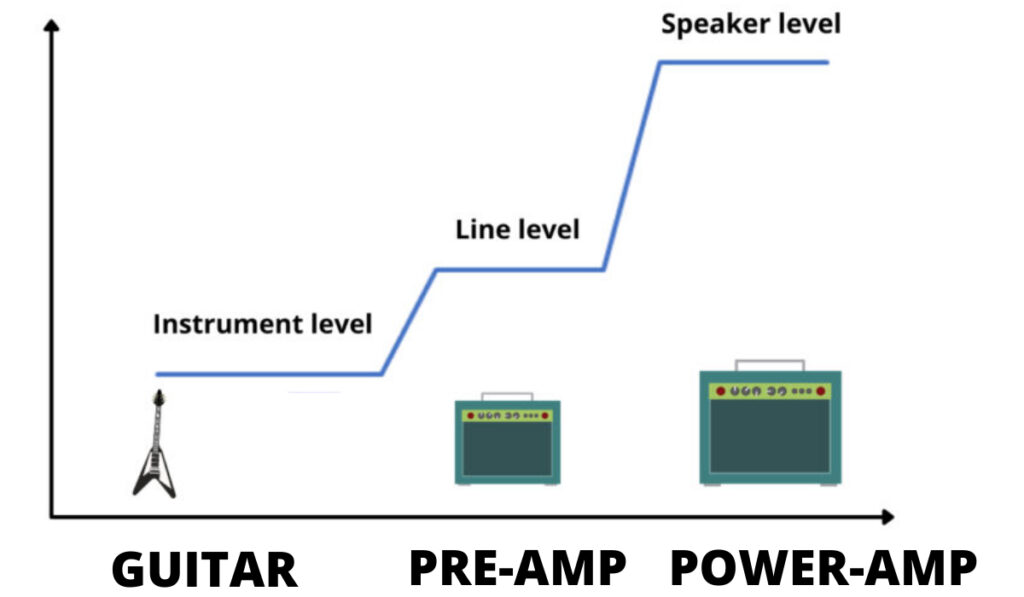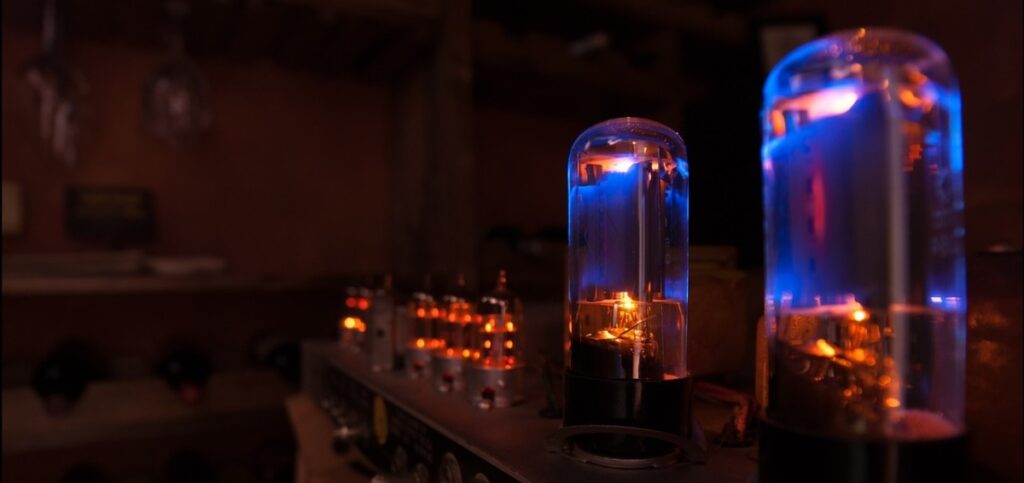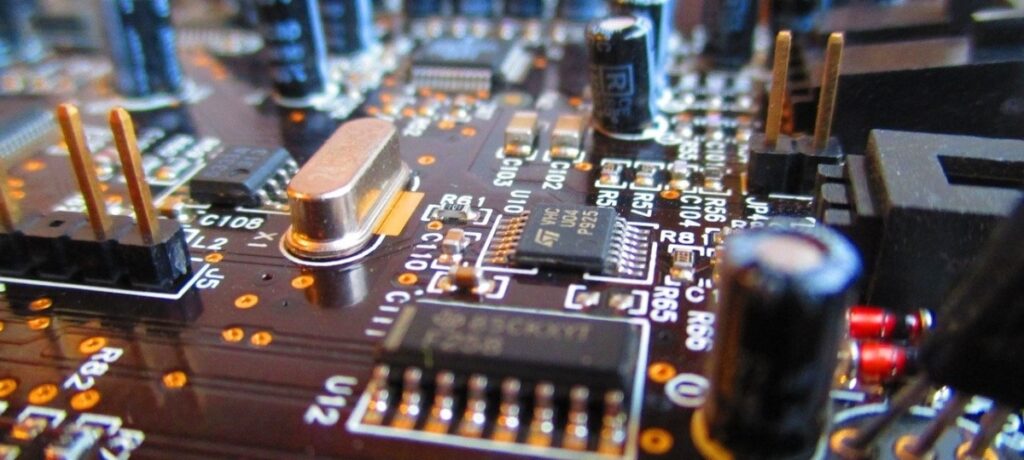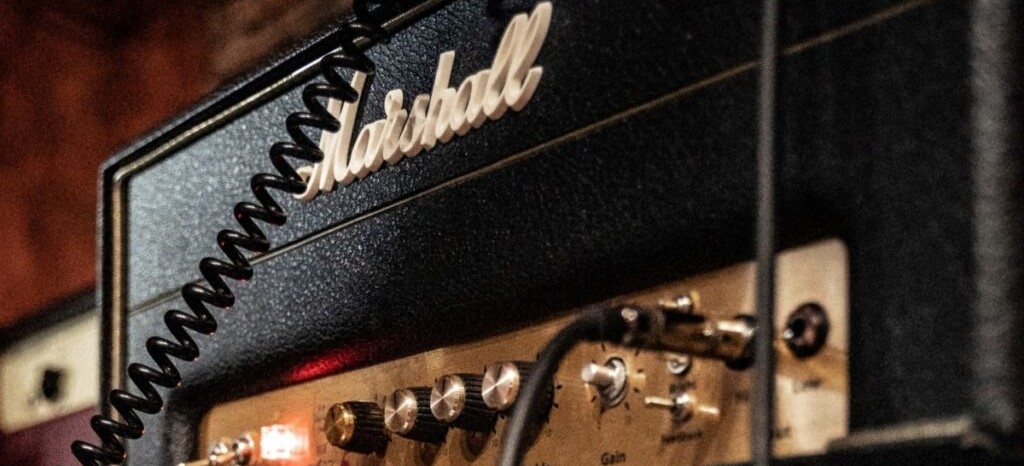If you’re looking to buy a new guitar amplifier, then one of the first things you’ll need to decide is if you want a tube (valve) amp, or a solid state amp. This will have a big impact on the tone, price, weight and versatility of your amp, just to name a few factors. In this article, I’ll be comparing tube and solid-state amps in-depth so you can figure out exactly which is the best type for you.
Tube vs Solid State Amp
Tube amps (also known as valve amps) use vacuum tubes which makes the tone richer and warmer and makes them more responsive to the guitar compared to solid state amplifiers which use transistors. Solid state amps are lighter, cheaper and easier to maintain than tube amps.
| Tube Amps | Solid State Amps |
| Use vacuum tubes | Use transistors |
| More responsive to the player | Less responsive to the player |
| Sound warmer and richer | Sound colder and harsher |
| More specific tone | More versatile |
| Sound louder | Sound quieter |
| Heavier and larger | Lighter and more compact |
| Need time to warm up before use | Can be used straight after switch on |
| Requires more maintenance | Requires very little maintenance |
| Typically cost between $200 and $3000 | Typically cost between $50 and $1000 |
There is no difference between tube amplifiers and valve amplifiers. “Tube” is the term used to describe this type of amp in America, whereas “valve” is the term used to describe them in the UK. This is why you may hear the terms being used interchangeably.

How do they Work?
Electric guitar amplifiers all have the same basic function which is to take the instrument level signal (produced by the guitar) and raise it to a level which is capable of driving a speaker (known as speaker level). Amps have two stages which are designed to do this.
- Pre-amp: this raises the instrument level signal (from the pickups) to line level signal
- Power-amp: this raises the line level signal to speaker level signal

The pre-amp stage of the amp is where you’ll find many of the controls such as channels, gain, volume, and EQ controls (bass, mids and treble) so it is primarily responsible for shaping how the tone sounds.
The way that the pre-amp and power-amp stages function differs between tube (valve) and solid-state amplifiers.
I’ll go through a quick overview here so you’ve got a basic understanding of the differences, but if you’re not a fan of the science then feel free to skip ahead!
Tube Amps
The pre-amp and power-amp sections of a tube amp consist of vacuum tubes (also known as valves) which are constructed from glass. These tubes amplify the signal from instrument to line to speaker level by controlling the current flow.

It’s not necessary to know the physics in too much detail, but here’s a brief overview of how a tube amplifier operates.
The tubes consist of a filament, cathode, anode and grid. Here’s how they work:
- The filament creates heat when the electrical current flows through it.
- The cathode releases electrons when it is heated by the filament located next to it.
- The anode attracts the electrons released by the cathode.
- The grid sits between the anode and cathode and is connected to the input from the guitar which receives a small charge (controlled by the anode and cathode).
The tubes in the pre-amp and power-amp are different due to their differing functions. There are also different types of tubes which all have a different structure to give the amp a unique tone.
Pre-Amp Tube Examples:
- 12AX7
- 12AT7
- 12AU7
- 12AY7
Power-Amp Tube Examples:
- EL34
- EL84
- 6L6
- 6V6
Solid State Amps
Solid state amps use transistors to convert the instrument level signal to line level signal in the pre-amp stage, and from line level signal to speaker level signal in the power-amp stage. This essentially means that the signal passes through a circuit board.
Instead of using tubes which are designed to sound more natural and warm, solid state amps have a more “digital” sound, which sounds a bit colder and harsher, but gives you more control over the tone.

Modelling Amps
The lines between tube and solid state amps are blurred slightly when it comes to modelling amps. Although they are still technically solid state amps (since they use transistors instead of tubes to amplify the signal), they use digital components to mimic the function of tubes to create a very similar tone.
Tone Comparison
Although tubes and transistors have the same function which is to take the guitar’s signal and amplify it, they characteristics are different.
Tubes are described as “non-linear”, meaning that the way they respond changes according to the signal level. If the signal is pushed harder, then clipping begins to occur which we hear as distortion. This distortion sounds very warm and full and with more compression and sustain.
Essentially, tube amps are more responsive to how the guitarist is playing. If they pick harder, the signal will be pushed harder.
Solid state amplifiers are less responsive and more “linear”. They have a colder and harsher tone in comparison to tube amps which many players feel sounds inferior.
There is a lot of stigma around the tone of solid state amps, however they have made huge advancements since they were originally released and it is now very hard to tell the difference between a tube and solid state amp.
Check out this video by Darrell Braun Guitar on YouTube to do a blind test of tube and solid state amps so you can figure out which you prefer the sound of without any preconceived notions.
It’s also worth listening to comparison of the Boss Katana (solid-state) and Fender Blues Junior (tube) by Toby’s Guitar Gear Demo as it gives a good idea of the types of sound that are achieved by tube and valves.
The Katana is one of the best solid-state amps on the market and many players will actually prefer the tone of it in comparison to a tube amp. It’s all personal preference!
Versatility
One of the benefits of a solid state amplifier over a tube amp, is that solid state amps are generally more versatile, particularly the modelling amp types. With a tube amp, the vacuum tubes will give the tone a unique flavour and although it can be adjusted with the EQ and gain controls, it will have a more specific tone.
With a solid state amp, the tone can be adjusted more to give the amp more versatility. Modelling amps often come with 10-100 presets which means you can get loads of tones out of the same amplifier to play different styles of music.
Volume
Tube amps are perceived as louder than solid-state amps even if they have the same wattage and are using the same speaker. In general, a tube amp will usually sound twice as loud as a solid state amp because of the way it distorts.
Hence, you should keep this in mind when selecting the wattage. If you currently have a 50W solid state amp and are happy with the volume, then you may only need a 25W tube amp to get the same effect.
Check out my article on how many watts an amplifier needs to be, to find out what range you should be looking at.

Headroom
Solid state amplifiers have more headroom than valve amplifiers. Headroom is the term used to describe how powerful the signal can be before the sound starts to distort. With a solid state amp, you will be able to turn the volume up to maximum and maintain a cleaner signal compared to with a tube amp.
Different tube amps have different levels of headroom. For example, typically Fender amps have more headroom than Marshall amps, meaning the Fender can be pushed more before the signal starts to distort compared to the Marshall.

This is an important consideration to make depending on the styles of music you play. If you want your amp to be distorted most of the time, you’ll need to push some tube amps to very loud volumes to achieve this effect which may not always be practical depending on your location.
There are work-arounds though, such as amp attenuators. However it’s worth mentioning the difference between the two types of amp.
In general, tube amps sound best when the volume is above 3, whereas solid state amps sound better at lower volumes and tend to sound worst at their maximum volume setting.
Weight
Tube amps are much heavier than solid state amplifiers due to the weight of the vacuum tubes in comparison to the transistors used in a solid state amp. Typically, tube amps will weight around 2-3 times more than solid-state amps of the same power rating (wattage). They will also have larger dimensions.
This is an important consideration to make if you’re going to be transporting the amplifier frequently. Check out this table for some examples of the weight of tube and solid state amps.
| Amplifier | Type | Dimensions (cm) | Weight (kg) | Wattage |
| Marshall MG10G | Solid State | 34.9 x 18.4 x 30.5 | 4.8 | 10W |
| Vox AC10C1 | Tube | 60.3 x 47.3 x 30.7 | 11.8 | 10W |
| Fender Champion 20 | Solid State | 40.6 x 30.5 x 40.6 | 5.4 | 20W |
| Marshall DSL20CR | Tube | 50.0 x 42.0 x 25.0 | 16.3 | 20W |
| Marshall MG30GFX | Solid State | 48.0 x 42.0 x 22.0 | 10.8 | 30W |
| Orange TremLord-30 | Tube | 57.5 x 46.5 x 29.0 | 29.1 | 30W |
| Peavey Vypyr X2 | Solid State | 45.0 x 49.5 x 25.4 | 12.7 | 40W |
| Blackstar HT Venue 40 | Tube | 58.8 x 48.0 x 26.0 | 24.0 | 40W |
| Boss Katana 50 | Solid State | 47.0 x 23.8 x 39.8 | 11.6 | 50W |
| Marshall JMV215 | Tube | 60.5 x 51.0 x 26.5 | 26.5 | 50W |
Maintenance
Solid state amps are very reliable and rarely require maintenance. Tube amps on the other hand are much less reliable because the vacuum tubes are made from glass and can get broken and need replacing. Typically, the tubes should less for at least 5000 hours of playing or every 2-3 years before the tone will start to suffer and they need replacing.
Tube amps also need to warm up before playing to be able to function properly. As a general rule, it’s best to wait at least 20 minutes after turning the amp on until you play the guitar. Solid state amps on the other hand can be switched on and played straight away.
Price Difference
Tube amps are much more expensive than solid state amplifiers. Typically, solid state combo guitar amps start at $80 and range up to $500, whereas tube combo amps start at $500 and range up to $3000. Solid state head units start at approximately $200 and valve head units at around $300.
Here is a table showing some popular amp types and their average prices at the time of writing.
Combo Amps
| Amplifier | Price | Wattage | Technology |
| Fender Frontman 10G 10W | $80 | 10W | Solid State |
| Line 6 Spider V 20 | $150 | 20W | Solid State |
| Blackstar ID: Core 40 | $200 | 40W | Solid State |
| Fender Mustang 50XL | $250 | 50W | Solid State |
| Boss Katana 100 | $400 | 100W | Solid State |
| Marshall Origin20C | $550 | 20W | Tube |
| Marshall DSL40CR | $800 | 40W | Tube |
| Roland Blues Cube Artist | $980 | 80W | Solid State |
| Fender 68 Custom Pro Reverb | $1300 | 40W | Tube |
| Laney GH50R-212 | $1650 | 50W | Tube |
| Marshall JMV205C | $2600 | 50W | Tube |
Head Units
| Amplifier | Price | Wattage | Technology |
| Boss Katana KTN | $350 | 100W | Solid State |
| Marshall Origin20H | $450 | 20W | Tube |
| Orange Crush Pro CR120H | $450 | 120W | Solid State |
| Blackstar HT-20RH | $600 | 20W | Tube |
| Randall RG1003H | $780 | 100W | Solid State |
| Laney GH50R | $1200 | 50W | Tube |
| Randall RD100H | $2000 | 100W | Tube |
Check out my complete amplifier buyer’s guide to take you through all the different options and how to find the best amp for you.
